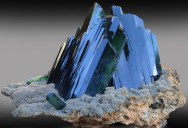Vivianite Is A Strange Mineral Crystal That Grows In A Very Gruesome Place

There is so much about the world we live in that is mysterious – at least to laypeople who don’t know the ins and outs of everything.
Like, say, a crystal that grows best on dead things.
Vivianite is a rare phosphate mineral that is typically found growing on organic materials like fossil shells, animal waste deposits, and on human corpses.
English mineralogist John Henry Vivian first discovered the crystals in Cornwall in 1817, and that is where they get their name.
It’s vividly colored and develops in iron-rich sedimentary deposits that contain organic material.

They are also found in hydrothermal replacement deposits, as well as phosphate-rich granite pegmatites.
It’s very fragile and is pale until oxidation takes place, which darkens the pigment to blue, dark green and purple, and finally a purplish black.
It forms thanks to the interaction between iron, water, and phosphate. Human bones contain phosphate that leeches into the environment as we decompose, and if the surrounding matter contains iron and water as well, vivianite is formed.
The mineral has been found on the bones and teeth of corpses that have been decomposing for several centuries, as well as on surfaces like mammoth tusks.
It has occasionally been seen on more recently deceased human bodies as well.
The conditions have to be just right in order for the mineral to grow quickly, and so we know of only a handful of documented cases over the past several decades.
I imagine it gives folks quite the start when first seen in the wild.
If you think that’s impressive, check out this story about a “goldmine” of lithium that was found in the U.S. that could completely change the EV battery game.

Sign up to get our BEST stories of the week straight to your inbox.




